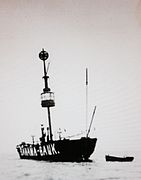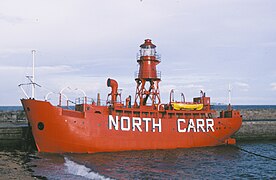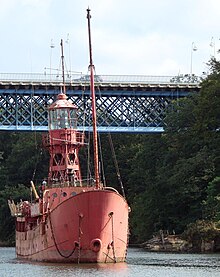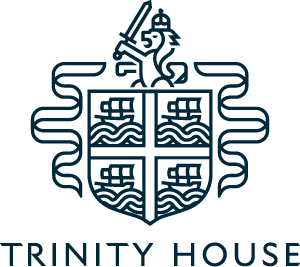
The Corporation of Trinity House of Deptford Strond, also known as Trinity House, is the official authority for lighthouses in England, Wales, the Channel Islands and Gibraltar. Trinity House is also responsible for the provision and maintenance of other navigational aids, such as lightvessels, buoys, and maritime radio/satellite communication systems. It is also an official deep sea pilotage authority, providing expert navigators for ships trading in Northern European waters.

A lightvessel, or lightship, is a ship that acts as a lighthouse. They are used in waters that are too deep or otherwise unsuitable for lighthouse construction. Although some records exist of fire beacons being placed on ships in Roman times, the first modern lightvessel was located off the Nore sandbank at the mouth of the River Thames in London, England, and placed there by its inventor Robert Hamblin in 1734. Lightships have since become largely obsolete; being largely replaced by lighthouses as construction techniques advanced, and by large automated navigation buoys.
Lightvessels in Ireland describes any lightvessel or light float previously stationed off the coast of Ireland. The Commissioners of Irish Lights are responsible for the majority of marine navigation aids around the whole of the island of Ireland.

Goodwin Sands is a 10-mile-long (16 km) sandbank at the southern end of the North Sea lying 6 miles (10 km) off the Deal coast in Kent, England. The area consists of a layer of approximately 25 m (82 ft) depth of fine sand resting on an Upper Chalk platform belonging to the same geological feature that incorporates the White Cliffs of Dover. The banks lie between 0.5 m above the low water mark to around 3 m (10 ft) below low water, except for one channel that drops to around 20 m (66 ft) below. Tides and currents are constantly shifting the shoals.

The Thames Estuary is where the River Thames meets the waters of the North Sea, in the south-east of Great Britain.

The Nore is a long bank of sand and silt running along the south-centre of the final narrowing of the Thames Estuary, England. Its south-west is the very narrow Nore Sand. Just short of the Nore's easternmost point where it fades into the channels it has a notable point once marked by a lightship on the line where the estuary of the Thames nominally becomes the North Sea. A lit buoy today stands on this often map-marked divisor: between Havengore Creek in east Essex and Warden Point on the Isle of Sheppey in Kent.
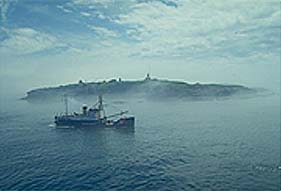
A lighthouse tender is a ship specifically designed to maintain, support, or tend to lighthouses or lightvessels, providing supplies, fuel, mail, and transportation. The work is often carried out by ships which also act as buoy tenders.
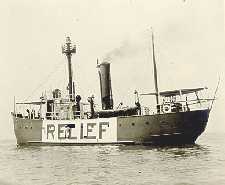
The United States lightship Huron (LV-103) is a lightvessel that was launched in 1920. She is now a museum ship moored in Pine Grove Park, Port Huron, St. Clair County, Michigan.

Sevenstones Lightship is a lightvessel station off the Seven Stones Reef which is nearly 15 miles (24 km) to the west-north-west (WNW) of Land's End, Cornwall, and 7 miles (11 km) east-north-east (ENE) of the Isles of Scilly. The reef has been a navigational hazard to shipping for centuries with seventy-one named wrecks and an estimated two hundred shipwrecks overall, the most infamous being the oil tanker Torrey Canyon on 18 March 1967. The rocks are only exposed at half tide. Since it was not feasible to build a lighthouse, a lightvessel was provided by Trinity House. The first was moored near the reef on 20 August 1841 and exhibited its first light on 1 September 1841. She is permanently anchored in 40 fathoms (73 m) and is 2.5 miles (4.0 km) north-east (NE) of the reef. Since 1987, the Sevenstones Lightship has been automated and unmanned.

Sandettie is a lightvessel station located at Sandettie Bank in the North Sea. It is one of the 22 coastal weather stations whose conditions are reported in the BBC Shipping Forecast. The vessel is named after her location on the Sandettie Bank, due north of Calais and due east of the South Foreland. The ship has no engine and is not crewed. Its lights are powered by solar panels.

Channel was the name of a lightvessel station located in the English Channel between 1979 and August 2021, when it was replaced with a light buoy. It was also one of the 22 coastal weather stations whose conditions were reported in the BBC Shipping Forecast. The vessel's position was 49°55′N2°54′W, approximately 56 km (35 mi) north-northwest of Guernsey.
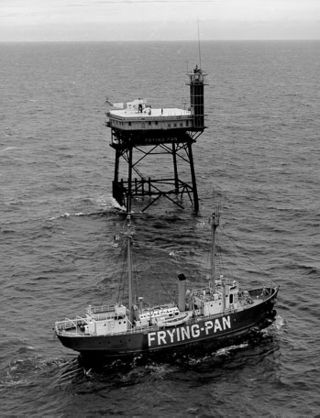
Frying Pan (LV-115) is a lightvessel moored at Pier 66a in the Chelsea neighborhood of Manhattan in New York City. It served at Frying Pan Shoals, off Cape Fear in North Carolina, for over 30 years.
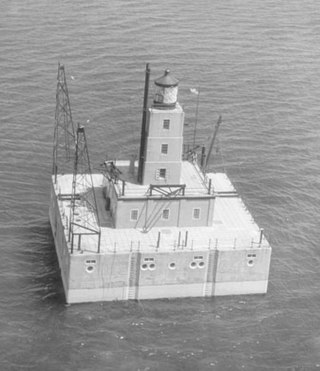
The Lansing Shoals Light Station is a lighthouse located in northeastern Lake Michigan, 6.3 miles (10.1 km) southeast of Point Patterson, in Newton Township, Mackinac County, Michigan. It was listed on the National Register of Historic Places in 2005.
The Kentish Knock is a long shoal in the North Sea east of Essex, England. It is the most easterly of those of the Thames Estuary and its core, which is shallower than 18 feet (5.5 m), extends 6 miles (9.7 km). Thus it is a major hazard to deep-draught navigation. It is exactly 28 miles (45 km) due east of Foulness Point, Essex and is centred about 15 miles (24 km) NNE of North Foreland, Kent – both are extreme points of those counties.
The Sandettie Bank is an elongated sandbank in the southern North Sea, more specifically about in the middle of the northeastern entrance to the Strait of Dover. North-west of it are the hazardous Goodwin Sands, south of it the sandbank Ruytingen.

The Bahama Bank Lightship was a Lightvessel stationed on the Bahama Bank east of Ramsey Bay, Isle of Man.
The Inner and Outer Dowsing sand banks are shallow-water shoals off the Lincolnshire coast of the UK sector of southern North Sea. They have been used for navigation, as a commercial fishery, for aggregate dredging, and more recently as the location for major offshore wind farms.

Light Vessel 95 is a former lightship that has been used as a recording studio since the early 2000s. She was built by Philip and Son at Dartmouth, Devon, in 1939 for Trinity House, the body responsible for provision of maritime navigation aids in England and Wales. Light Vessel 95 served at Goodwin Sands, The Wash, Varne Bank and at the Sevenstones Station. She was among the last ten light vessels in Trinity House service and was converted to automatic operation in the 1990s. Light Vessel 95 was sold in 2003 and converted into a recording studio. Since 2008 she has been moored at Trinity Buoy Wharf in London.

Light Vessel 93 was a light vessel of Trinity House, currently used as a photography studio. She was built in Dartmouth, Devon, in 1938 and served on stations including Galloper sand bank, the River Thames, Goodwin Sands, Inner Dowsing, Sunk Sands and Foxtrot 3. She was sold to Michele Turriani in 2004 and converted into a studio operating at Royal Victoria Dock in London. Turriani attempted to sell the vessel from 2020. In 2024 Light Vessel 93 was moved to King George V Dock.










